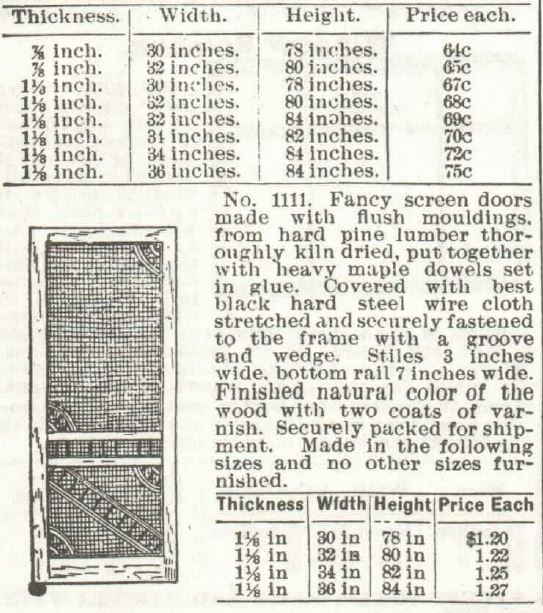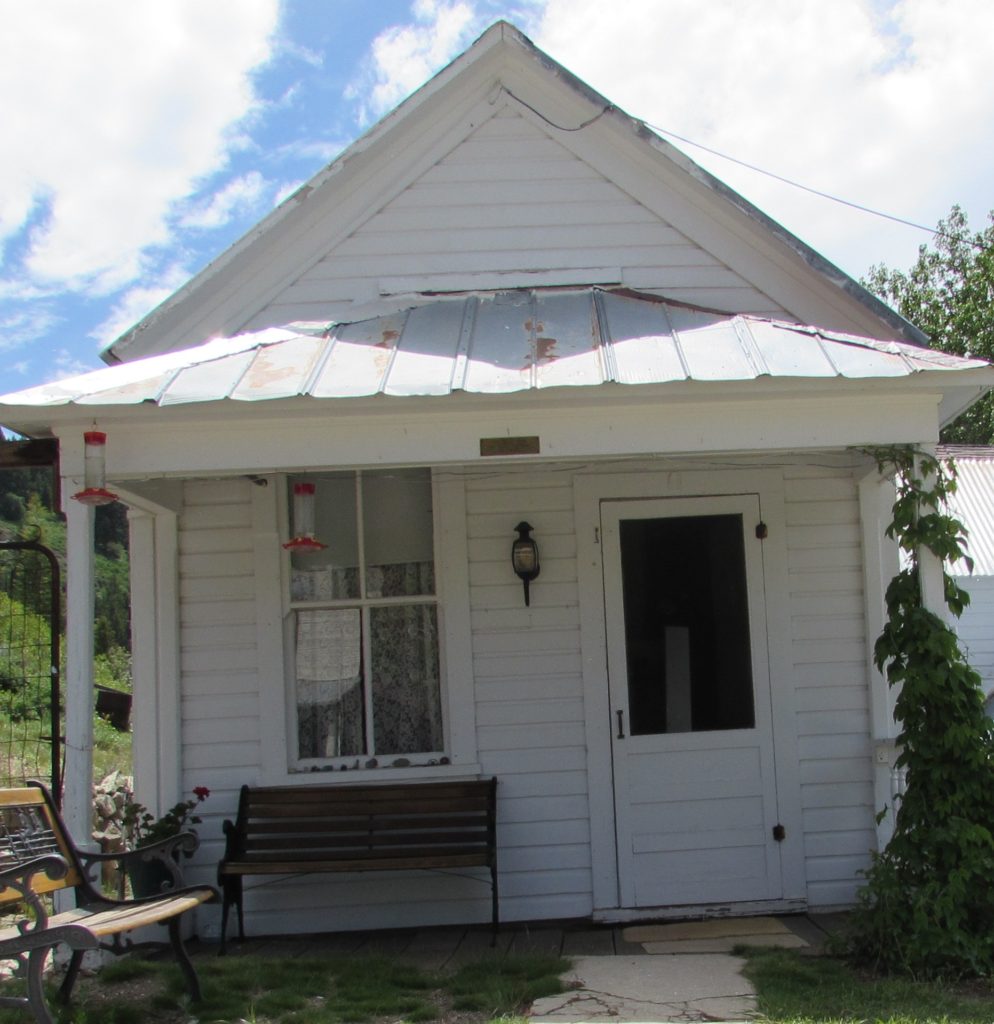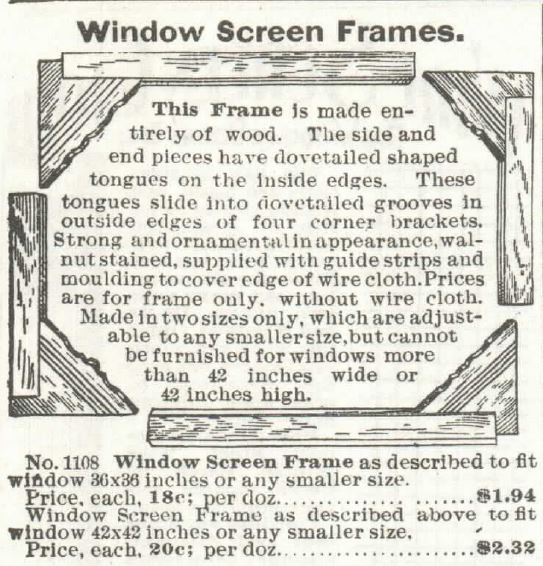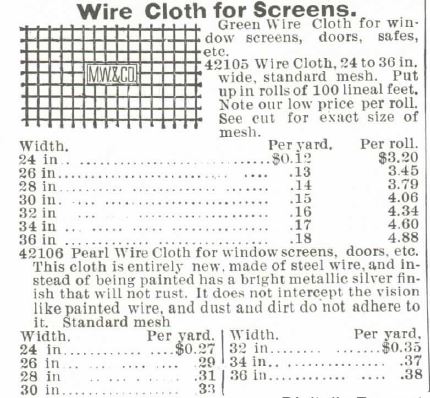Screen Doors, a new invention!
Screen Doors, a new invention!
.

.
POP QUIZ:
Were screen doors and window screens invented BEFORE 1870, or AFTER?
.
We’ve all read western historical romances where the heroine sets her pie on the windowsill to cool (apparently in the kitchen), but that wouldn’t work (especially the pie thieving aspect) if a screen were in the window. We’ve also all read a western historical romance where the screen door bangs shut as an exclamation point to the heroine’s argument, trying to get the hero to see things her way.
.
So, before 1870, or after?
.

Screen Door of Stricker Mansion, Stricker Ranch, Twin Falls County, Idaho. Image: Taken by Kristin Holt, June 2016.
.

.
Before wire cloth or mesh was used for window screens and door screens, people sometimes used cheesecloth to cover their windows to keep out flies and other insects. Cheesecloth is loosely woven and so will allow air to circulate, but it is delicate and easily torn. Wire cloth was woven of fine metal wire, originally for sieves to sift flour and strain food.
.
During the U.S. Civil War (1861 – 1865), Gilbert and Bennett, a company of sieve makers in Connecticut, had a growing surplus because they could no longer sell in the Southern states. An employee of the company had a new idea: he coated the wire cloth with paint to prevent rust and sold it for window screens. The idea was so popular that the company made wire cloth a major part of its business, and it became a major manufacturer of screens for doors and windows. Later, the company introduced steel wire, which was resistant to rust.
.
.
AND…
.
“Wove wire for window screens” were referenced in the American Farmer in 1823. Advertisement for wire window screens appeared in Boyd’s Blue Book in 1836. Two wire window screens were exhibited at Quincy Hall in Boston in 1839.
In 1861 Gilberr, Bennett and Company was manufacturing wire mesh sieves for food processing. An employee realized that the wire cloth could be painted gray and sold as window screens and the product became an immediate success. On July 7, 1868, Bayley and McCluskey filed a U.S. Patent, number 79541 for screened roof-top rail-car windows, allowing ventilation, while preventing “sparks, cinders, dust, etc.” from entering the passenger compartment.
By 1874, E.T. Barnum Company of Detroit, Michigan advertised screens that were sold by the square foot. Apparently, window screens designed specifically to prevent insect entry were not patented in the United States, although by 1900 several patents were awarded for particular innovations related to window screen design. By the 1950s, parasitic diseases were largely eradicated in the United States in part due to the widespread use of window screens.
.
[Italics and bold-face added.] [source]
.
ANSWER:
Undeniably BEFORE 1870.
.
Does that surprise you? It surprised me!
.

.
SCREEN DOORS in Victorian America
.

1 of 2). Screen Doors for sale by Sears Roebuck & Co. Catalogue, 1897

2 of 2). Screen Doors for sale by Sears Roebuck & Co. Catalogue, 1897
.

1 of 2). Screen Doors for sale by Montgomery Ward Spring & Summer Catalogue No. 57, 1895.

2 of 2). Screen Doors for sale by Montgomery Ward Spring & Summer Catalogue No. 57, 1895.
.

Catches for Screen Doors for sale by Montgomery Ward Spring & Summer Catalogue, No. 57, 1895.
.
![]()
.

Screen Door Private Residence in Historic Silver City, Idaho. Image: Taken by Kristin Holt, June 2016.
.

.
WINDOW SCREENS in Victorian America
.

1 of 2). Window screen frames in the Sears Roebuck & Co. Catalogue, 1897

2 of 2). Window screens, Sears Roebuck & Co. Catalogue, 1897
.

1 of 2). Wire Cloth for Screens for sale by Montgomery Ward Spring & Summer Catalogue, No. 57, 1895.

2 of 2). Wire Cloth for Screens for sale by Montgomery Ward Spring & Summer Catalogue, No. 57, 1895.
.

.
Related Articles
.
Updated May 2022
Copyright © 2016 Kristin Holt LC
Screen Doors, a new invention! Screen Doors, a new invention!































Very interesting article, as usual, Kristin. I enjoy each of your posts. I always learn something new and valuable for my writing. Thank you.
Thank you, Marianne–
I’m so glad you enjoyed this article and my posts in general. I’m pleased you find my articles valuable and benefit from learning more detail of American Victorian history.
Happy Writing!
Kristin Holt
I love this and totally have one in my 1870 release coming out on Monday! Thanks for the insight and for being so on the pulse of things!
You’re most welcome, Kelli Ann! Glad to be of help. Congratulations on the new release, set in 1870! Looking forward to the excellent read.
Wow! That’s a very interesting look at the history of screen doors. Not many people would think it would be interesting, but people have had doors for hundreds of years, and a screen door is, in a sense, an evolution of the door. Thank you for sharing!
Thanks, Amy, for stopping by and contributing to the conversation. Glad you enjoyed.
This is very helpful, Kristin! I know it’s years since you posted it, but I am writing a historical fiction western and wanted to include a screen door in my description. Thank you for confirmation that I can!
You’re most welcome, Sandy. Thanks so much for stopping by, and for loving accuracy in historical western titles as much as I do. Isn’t it fantastic to know such inventions were around when we needed them to be?
Warmest regards,
Kristin Holt